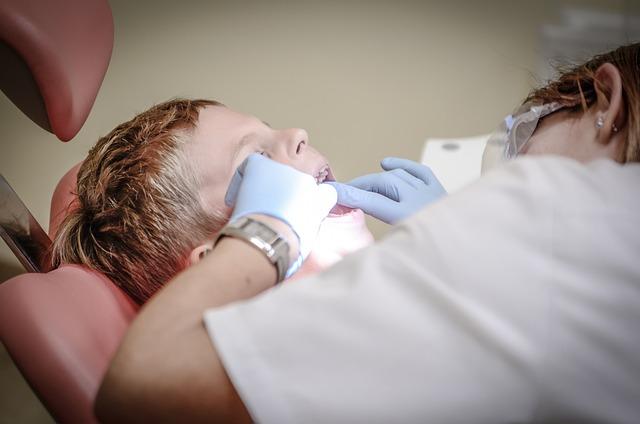His Name is Tooth Decay: Understanding the Enemy of Healthy Smiles
In the ongoing battle for healthy smiles, there is an enemy lurking in the shadows, silently wreaking havoc on our teeth. Its name is Tooth Decay, and it is a force to be reckoned with. Understanding this formidable foe is crucial in our quest for optimal oral health. From the science behind its formation to the strategies for prevention, this article delves deep into the realm of Tooth Decay, equipping you with knowledge to protect your precious pearly whites. So, buckle up and get ready to face this formidable opponent head-on, armed with the power of understanding.
1. Unveiling the Culprit: A Comprehensive Look into Tooth Decay
Tooth decay is a prevalent dental problem that affects people of all ages. Understanding the underlying causes of tooth decay is essential for maintaining optimal oral health. In this comprehensive guide, we will delve into the various factors contributing to tooth decay and provide valuable insights into prevention and treatment.
Factors contributing to tooth decay:
- Poor oral hygiene: Inadequate brushing and flossing allow plaque to build up on the teeth, leading to decay.
- Dietary choices: Consuming sugary and acidic foods and beverages increases the risk of tooth decay.
- Insufficient fluoride: Lack of fluoride, a mineral that strengthens tooth enamel, can make teeth more susceptible to decay.
- Plaque buildup: The sticky film of bacteria, known as plaque, constantly forms on teeth and gradually erodes the enamel if not removed regularly.
Prevention and treatment:
- Regular brushing and flossing: Proper oral hygiene practices, including brushing at least twice a day and flossing daily, are crucial for preventing tooth decay.
- Fluoride use: Using fluoride toothpaste and rinsing with fluoride mouthwash can help strengthen tooth enamel and prevent decay.
- Healthy diet: Limiting sugary and acidic foods while incorporating calcium-rich foods can promote strong teeth and prevent decay.
- Dental visits: Regular dental check-ups and cleanings allow for early detection and treatment of tooth decay, preventing further damage.
By gaining a comprehensive understanding of tooth decay and implementing effective preventive measures, you can maintain a healthy smile and preserve your oral health for years to come.
2. Unmasking Tooth Decay: The Secret Threat to a Bright Smile
Tooth decay is a hidden enemy that can wreak havoc on your smile without you even realizing it. It’s a common dental problem that occurs when the bacteria in your mouth produce acids that eat away at the enamel of your teeth. If left untreated, tooth decay can lead to serious oral health issues, such as cavities, gum disease, and even tooth loss.
Here are some key points to help you understand the threat of tooth decay:
- Causes: Poor oral hygiene, frequent snacking on sugary foods and drinks, and certain medical conditions can all contribute to tooth decay.
- Signs and symptoms: At first, tooth decay may not cause any noticeable symptoms. However, as it progresses, you may experience tooth sensitivity, pain when biting down, or visible holes or stains on your teeth.
- Prevention: The good news is that tooth decay is preventable! By practicing good oral hygiene, such as brushing twice a day, flossing daily, and visiting your dentist regularly, you can significantly reduce your risk of developing tooth decay.
Remember, maintaining a bright smile goes beyond just having pearly whites. It also means taking care of your teeth to prevent tooth decay. By understanding the causes, recognizing the signs, and implementing preventive measures, you can unmask the threat of tooth decay and keep your smile healthy and radiant.

3. The Battle Begins: Understanding the Fundamentals of Tooth Decay
Tooth decay is a common dental issue that affects millions of people worldwide. Understanding the fundamentals of tooth decay is crucial in order to prevent and treat this condition effectively. Here are some key points to help you grasp the basics:
Causes of Tooth Decay:
- Poor oral hygiene: Not brushing and flossing regularly allows plaque to build up, leading to decay.
- Dietary factors: Consuming sugary and acidic foods and drinks increases the risk of tooth decay.
- Plaque buildup: When bacteria in the mouth combine with saliva and food particles, they form a sticky film called plaque. If not removed, plaque can erode tooth enamel and cause decay.
Stages of Tooth Decay:
Tooth decay progresses in stages, starting with the initial demineralization of the enamel and ending with the formation of a cavity. Understanding these stages can help you identify and address decay early:
- Stage 1: Enamel demineralization - The outer layer of the tooth, the enamel, begins to lose minerals due to acid attacks.
- Stage 2: Enamel decay – The enamel starts to break down, forming a small hole or pit.
- Stage 3: Dentin decay – Decay spreads to the dentin, the layer beneath the enamel, causing increased sensitivity and pain.
- Stage 4: Pulp infection – If decay reaches the innermost part of the tooth, the pulp, it can lead to severe pain, abscess formation, and potential tooth loss.
Prevention and Treatment:
Preventing tooth decay involves adopting good oral hygiene practices, such as brushing twice a day with fluoride toothpaste, flossing daily, and visiting the dentist regularly. Additionally, reducing sugar consumption and maintaining a balanced diet can help protect your teeth. If decay has already occurred, treatment options may include dental fillings, crowns, or root canals, depending on the severity of the damage.

4. Decoding Dental Demons: How Tooth Decay Destroys Oral Health
Tooth decay is a common dental issue that can have a devastating impact on oral health. Understanding how it occurs and its consequences is crucial for maintaining a healthy smile. Here, we decode the dental demons behind tooth decay, shedding light on this destructive process.
1. Bacteria: The primary culprit behind tooth decay is bacteria, specifically a group of bacteria known as Streptococcus mutans. These bacteria reside in the mouth and feed on the sugars and carbohydrates from the food we consume. As they feed, they produce acids that gradually erode the protective enamel covering our teeth, leading to decay.
2. Plaque Formation: As bacteria multiply, they form a sticky film called plaque that adheres to the tooth surfaces. Plaque provides an ideal environment for bacteria to thrive, making it harder to remove them through regular brushing and flossing alone. Over time, the acids produced by bacteria in plaque begin to attack the enamel, causing it to weaken and develop cavities.
3. Acid Attack: When we consume sugary or acidic foods and beverages, the bacteria in our mouth produce even more acids. These acids, combined with the existing plaque, create a highly acidic environment that further demineralizes the enamel. If left untreated, this acid attack can progress, leading to larger cavities and potential tooth infections.
Protecting against tooth decay involves maintaining good oral hygiene practices such as regular brushing and flossing, as well as visiting the dentist for professional cleanings and check-ups. By understanding the dental demons behind tooth decay, we can take proactive steps to preserve our oral health and keep our smiles shining bright.

5. The Silent Saboteur: How Tooth Decay Sneaks Up on Healthy Smiles
Tooth decay is a common dental problem that often goes unnoticed until it has already caused significant damage. This silent saboteur can sneak up on even the healthiest smiles, leading to pain, infection, and the need for extensive dental treatments. Understanding how tooth decay develops and the steps to prevent it are essential for maintaining good oral health.
Here are some key points to keep in mind:
- Causes of tooth decay: Tooth decay is primarily caused by the interaction between bacteria in the mouth and sugars or starches from food and beverages. These bacteria produce acids that erode the tooth enamel over time, leading to cavities.
- Early signs and symptoms: In the early stages, tooth decay may not cause any noticeable symptoms. However, as it progresses, individuals may experience tooth sensitivity, pain when biting or chewing, visible holes or pits in the teeth, and bad breath.
- Prevention is key: Adopting a thorough oral hygiene routine is the best defense against tooth decay. This includes brushing your teeth twice a day with fluoride toothpaste, flossing daily, limiting sugary and acidic foods and beverages, and visiting your dentist regularly for check-ups and cleanings.
By staying vigilant and taking proactive measures to prevent tooth decay, you can protect your oral health and maintain a beautiful smile for years to come.

6. Dental Armageddon: Unraveling the Devastating Effects of Tooth Decay
Tooth decay is a prevalent dental issue that affects millions of people worldwide. Its consequences can be devastating, leading to a dental armageddon if left untreated. Understanding the effects of tooth decay is crucial in order to take appropriate preventive measures and seek prompt treatment. Here, we unravel the various ways in which tooth decay can wreak havoc on your oral health:
- Cavities: Tooth decay begins with the formation of cavities, which are small holes in the teeth caused by acid erosion. These cavities weaken the tooth structure and can lead to pain and sensitivity.
- Gum Disease: If tooth decay progresses, it can spread to the gum line, causing gum disease. This can lead to inflammation, bleeding gums, and even tooth loss if left untreated.
- Bad Breath: The bacteria that thrive in decaying teeth can emit foul odors, resulting in persistent bad breath that may be difficult to eliminate.
- Discoloration and Staining: Tooth decay can cause the affected teeth to become discolored or stained. This can significantly impact your smile and self-confidence.
- Root Canal Infections: In severe cases, tooth decay can reach the inner pulp of the tooth, leading to painful infections that may require root canal treatment or even tooth extraction.
By understanding the devastating effects of tooth decay, you can take proactive steps to maintain good oral hygiene, visit your dentist regularly, and seek timely treatment for any signs of decay. Remember, prevention is always better than a dental armageddon!
7. Shielding Your Smile: Proven Strategies to Combat Tooth Decay
Tooth decay is a common dental problem that affects people of all ages. However, with the right strategies, you can protect your smile and prevent tooth decay. Here are some proven strategies that you can implement to combat tooth decay:
- Brush and floss regularly: Proper oral hygiene is crucial in preventing tooth decay. Make sure to brush your teeth at least twice a day, using a fluoride toothpaste, and floss daily to remove plaque and food particles from between your teeth.
- Limit sugary and acidic foods: Sugary and acidic foods can contribute to tooth decay. Limit your intake of sweets, sodas, and acidic drinks like citrus juices. If you do consume them, rinse your mouth with water afterward and try to brush your teeth 30 minutes later.
- Consider dental sealants: Dental sealants are thin coatings applied to the chewing surfaces of the back teeth. They act as a barrier, protecting the teeth from bacteria and acids that cause decay. Talk to your dentist about whether dental sealants are a suitable option for you.
By implementing these strategies, you can effectively combat tooth decay and maintain a healthy, beautiful smile. Remember to visit your dentist regularly for check-ups and cleanings to ensure optimal oral health.
8. From Prevention to Restoration: The Roadmap to a Cavity-Free Mouth
Ensuring a cavity-free mouth is not just about prevention, but also involves restoration when necessary. Here is a comprehensive roadmap to help you achieve and maintain a healthy, cavity-free smile:
- Maintain a Proper Oral Hygiene Routine: Brush your teeth at least twice a day using a fluoride toothpaste, and don’t forget to floss daily. This helps remove plaque and bacteria that can lead to cavities.
- Visit Your Dentist Regularly: Schedule regular dental check-ups and cleanings every six months to catch any potential cavities early and address any existing dental issues.
- Optimize Your Diet: Limit sugary and acidic foods and beverages, as they can contribute to tooth decay. Instead, opt for a balanced diet rich in fruits, vegetables, and dairy products, which promote healthy teeth and gums.
- Consider Dental Sealants: Dental sealants are thin, protective coatings applied to the chewing surfaces of your back teeth. They act as a barrier against bacteria and can significantly reduce the risk of developing cavities.
- Fluoride Treatments: Fluoride treatments help strengthen tooth enamel and make it more resistant to acid attacks. Your dentist may recommend fluoride varnishes, gels, or rinses to enhance your cavity prevention efforts.
- Address Dental Issues Promptly: If you experience tooth sensitivity, pain, or any other dental problems, seek professional help immediately. Early intervention can prevent small issues from turning into extensive dental treatments.
- Practice Good Oral Habits: Avoid habits like smoking or using tobacco products, as they can increase the risk of tooth decay and gum disease. Additionally, maintain a healthy lifestyle that includes regular exercise and stress management, as they contribute to overall oral health.
By following this roadmap, you can take proactive steps towards a cavity-free mouth. Remember, prevention is key, but restoration plays a vital role in maintaining optimal oral health. Consult with your dentist for personalized guidance and ensure a lifelong, healthy smile.
9. Beyond the Surface: Delving into the Science Behind Tooth Decay
In order to understand tooth decay, it is important to delve into the science behind it. Tooth decay, also known as dental caries, is a common oral health problem that occurs when the bacteria in your mouth produce acids that eat away at the enamel, the protective outer layer of your teeth. Here are some key points to consider:
- Oral bacteria: The primary cause of tooth decay is the presence of specific bacteria, such as Streptococcus mutans, in your mouth. These bacteria feed on the sugars in the food you consume and produce acids as a byproduct.
- Acid erosion: The acids produced by oral bacteria lower the pH level in your mouth, leading to a process called demineralization. This involves the loss of essential minerals, such as calcium and phosphate, from the tooth enamel, making it vulnerable to decay.
- Plaque formation: When the acids and bacteria combine with food particles and saliva, they form a sticky film called dental plaque. Plaque adheres to the teeth and provides a breeding ground for more bacteria, exacerbating the decay process.
It is important to note that tooth decay is a preventable condition. By practicing good oral hygiene habits, such as regular brushing and flossing, limiting sugary foods and drinks, and visiting your dentist for check-ups, you can significantly reduce your risk of developing tooth decay and maintain optimal oral health.
10. Conquering Tooth Decay: Empowering Individuals to Take Control of their Dental Health
Tooth decay is a common problem that affects millions of people worldwide, but it doesn’t have to be inevitable. By taking control of your dental health, you can conquer tooth decay and maintain a healthy smile for years to come. Here are some empowering tips and strategies to help you on your journey:
- Practice good oral hygiene: Brush your teeth at least twice a day with fluoride toothpaste and floss daily to remove plaque and food particles that can lead to decay.
- Limit sugary and acidic foods: Sugary and acidic foods can contribute to the growth of harmful bacteria in your mouth. Limit your consumption of these foods and opt for healthier alternatives.
- Visit your dentist regularly: Regular dental check-ups and professional cleanings are essential for early detection and prevention of tooth decay. Your dentist can also provide personalized advice and treatments to address any specific dental concerns you may have.
- Consider dental sealants: Dental sealants are a protective coating applied to the chewing surfaces of your back teeth. They create a barrier against bacteria and can significantly reduce the risk of cavities.
- Stay hydrated: Drinking plenty of water helps to wash away food particles and bacteria, maintaining a healthy balance in your mouth.
Remember, taking control of your dental health is empowering and can greatly reduce your risk of tooth decay. By following these simple tips and making oral care a priority, you can enjoy a lifetime of healthy, cavity-free teeth.
Frequently Asked Questions
Q: What is the main focus of the article “His Name is Tooth Decay: Understanding the Enemy of Healthy Smiles”?
A: The article aims to provide a comprehensive understanding of tooth decay and its impact on maintaining healthy smiles.
Q: Why is it important to understand tooth decay?
A: Understanding tooth decay is crucial because it is one of the most common oral health issues, affecting a large number of individuals worldwide. By comprehending the causes, symptoms, and prevention methods, we can take proactive steps to maintain optimal oral health.
Q: What exactly is tooth decay?
A: Tooth decay, also known as dental caries or cavities, is a process where the hard tissues of the tooth are gradually destroyed by acids produced by bacteria. This results in the formation of holes or cavities in the teeth.
Q: What are the main causes of tooth decay?
A: The primary cause of tooth decay is the presence of certain types of bacteria in the mouth. These bacteria feed on sugars and produce acids that erode the tooth enamel. Other contributing factors include poor oral hygiene, frequent snacking, sugary food and drinks, and insufficient fluoride exposure.
Q: What are the common symptoms of tooth decay?
A: Symptoms of tooth decay can vary, but frequently include tooth sensitivity, pain or discomfort while biting or chewing, visible holes or pits on the teeth, and discoloration. In some cases, individuals may not experience any noticeable symptoms until the decay has significantly progressed.
Q: How can tooth decay be prevented?
A: Preventing tooth decay involves adopting a good oral hygiene routine. This includes brushing teeth twice a day with fluoride toothpaste, flossing daily, and using mouthwash. Additionally, reducing sugar intake, visiting the dentist regularly for check-ups, and applying dental sealants or fluoride treatments can also help prevent tooth decay.
Q: Can tooth decay be reversed?
A: Tooth decay in its early stages, known as enamel demineralization, can be reversed with proper oral hygiene and fluoride exposure. However, once a cavity has formed, it cannot be reversed and requires dental treatment to restore the tooth.
Q: How can parents help prevent tooth decay in children?
A: Parents can play a vital role in preventing tooth decay in children by promoting good oral hygiene habits from an early age. This includes teaching proper brushing and flossing techniques, ensuring a healthy diet low in sugary snacks and drinks, and scheduling regular dental visits for professional cleanings and check-ups.
Q: Are there any alternative treatments or natural remedies for tooth decay?
A: While alternative treatments and natural remedies may be popular, it is important to note that they are not scientifically proven to effectively treat tooth decay. The most reliable and evidence-based approach is to follow the advice of dental professionals, maintain good oral hygiene practices, and seek appropriate dental treatment when necessary.
Q: How does tooth decay impact overall health?
A: Tooth decay not only affects oral health but can also have broader impacts on overall well-being. Advanced tooth decay can lead to severe pain, difficulty eating, and may even contribute to systemic health issues such as cardiovascular disease and diabetes. Therefore, addressing tooth decay promptly is crucial for maintaining both oral and general health.
Final Thoughts
In conclusion, “His Name is Tooth Decay: Understanding the Enemy of Healthy Smiles” sheds light on the importance of comprehending the adversary that threatens our oral health.
Throughout this article, we have explored the various facets of tooth decay, ranging from its causes to its detrimental impact on our smiles. By understanding the underlying factors, such as poor oral hygiene, unhealthy diets, and lack of regular dental care, we can empower ourselves to take proactive steps in preventing tooth decay.
One key takeaway is the significance of maintaining a consistent oral care routine. Brushing our teeth at least twice a day, flossing daily, and using mouthwash can significantly reduce the risk of tooth decay. Additionally, adopting a balanced diet that limits sugary and acidic foods and beverages can help in preserving our dental health.
Moreover, regular dental check-ups and professional cleanings are crucial for early detection and timely treatment of tooth decay. By partnering with our dentists, we can address any potential issues before they escalate into more serious problems.
Lastly, the article highlights the importance of spreading awareness about tooth decay and promoting oral health education. By sharing knowledge and encouraging healthy habits, we can collectively combat this common enemy and ensure brighter, healthier smiles for generations to come.
In conclusion, with the understanding gained from “His Name is Tooth Decay: Understanding the Enemy of Healthy Smiles,” we are equipped with the tools to defend ourselves against this menacing foe. Let us remain dedicated to our oral care routines, seek professional guidance, and advocate for oral health awareness, as we strive towards preserving our radiant smiles.






